Entries Tagged 'Fashion' ↓
May 26th, 2009 — Design, Fashion
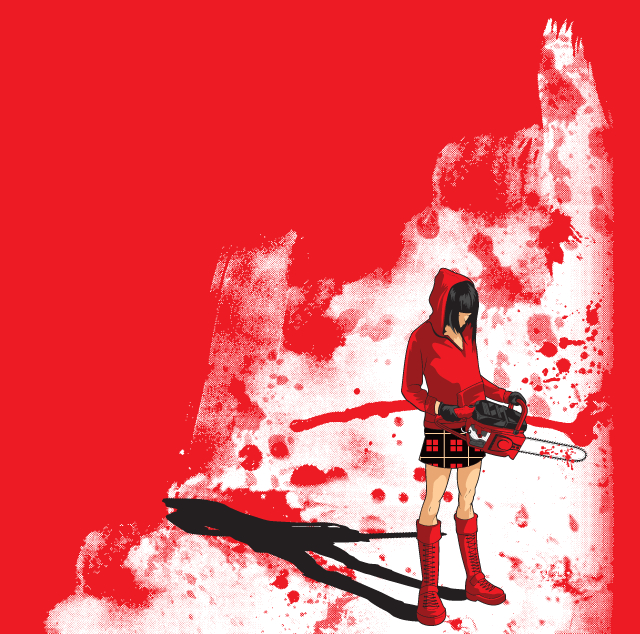
With a single, masterfully-composed image, above, designer Dina Prasetyawan‘s obliquely-titled T-shirt, “The Red”, undoes centuries of fairy tales, recasting storytelling’s most vulnerable victim, Little Red Riding Hood, as a Doc Martened-out, Japanese horror-style psychopath. Given the heft of that chainsaw, and the surrounding drench of blood, I’m guessing the Big Bad Wolf, Grandma, and the Woodsman all got done. Only $18 from Threadless.com.
May 7th, 2009 — Design, Fashion, Humor

“Beer goggles”—sexual judgement impaired by booze—is the excuse millions will be pushing this weekend, in order to explain why the eager hottie they eagerly shagged the night before looks like blechh in the golden morning’s light.
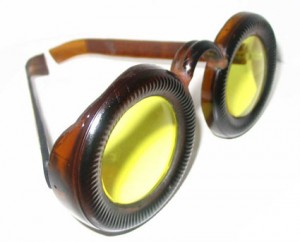 Well, if that’s your steez, why not just do you? “Beergoggles” are by Chicago-based custom eyeglasses maker Scott Urban of Urban Spectacles. They’re crafted out of spent containers of actual ale. That’s them to the right, and perched delicately on the suds-sucking lovely, above.
Well, if that’s your steez, why not just do you? “Beergoggles” are by Chicago-based custom eyeglasses maker Scott Urban of Urban Spectacles. They’re crafted out of spent containers of actual ale. That’s them to the right, and perched delicately on the suds-sucking lovely, above.
Explains Urban,
Continue reading →
April 20th, 2009 — Fashion, Humor
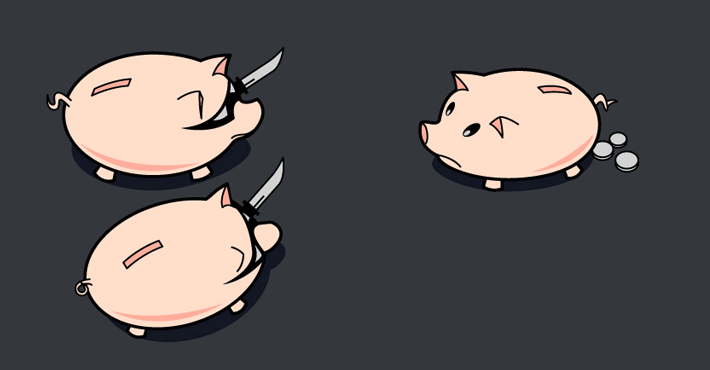
Somewhere amidst the urbane yet cannibalistic hogs of the Boost Mobile ad—hands down my favorite commercial of the not half-over year—and the knife-wielding ne’er-do-wells of Woonsocket, RI artist Jason LaRose’s t-shirt design, above, pigs just started turning on each other. (Favorite detail: Those coins the unnerved swine has dropped in fear.) Guess the recession is making all banks a little timid, and a little mean. “Piggy Bank Heist”: t-shirt, $18, men’s XS-3XL, women’s XS-2XL; zip-up hoodie, $40, S-2XL. By Threadless.
March 23rd, 2009 — Advertising, Fashion, History, Media, Race

So wrote Leroy Colson of Detroit MI this past Friday, in an e-mail to MEDIA ASSASSIN. The Lord and Taylor ad to which he refers, above, shows two models wearing pink, $150 Ellen Tracy trench coats.
Well, rather, one of them—the white one facing the camera—wears the coat. The other one—the Black one with her back to you—can’t help flashing a white man walking by with two dogs, both of which, if you look closely, have their eyes punningly trained on her putty-tat. The auburn-colored chow is even tugging like he’s gonna run after it.
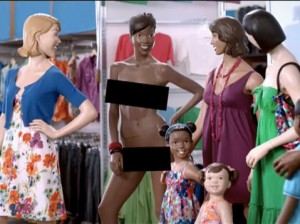 Colson tipped me to this image after he read this past Thursday’s post, “Are There Racists at Old Navy, or Do They Think That We’re Dummies?” That piece described what I perceived as the underlying racial code of the current Old Navy “Mid-Town Flash” commercial.
Colson tipped me to this image after he read this past Thursday’s post, “Are There Racists at Old Navy, or Do They Think That We’re Dummies?” That piece described what I perceived as the underlying racial code of the current Old Navy “Mid-Town Flash” commercial.
It’s the one in which a Black store mannequin, above right, has her dress ripped off, leaving her, except for matching black bars, naked before her co-mannequins, as the incident is played for laughs, including her own.
Exactly what are the chances that a random individual, reading an article critiquing the public racial display of the nude Black female body, would, that same day, be sent another, unrelated ad, also racially displaying the nude Black female body in public? (By racial, I mean anything said or done that involves white people with non-white people.)
Maybe the chances are high. Perhaps having noticed such an ad, a viewer’s heightened attention might readily be drawn to another different one. But, hey: Are there that many of these around? Is this a sub-category? I mean, we’re not talking about something akin to the millions of spreads featuring pictures of, say, mothers gently feeding their babies, here, right?
 Oops: I spoke too soon, suddenly recalling clothing maker Benetton’s notorious 1989 ad, right, something the company called part of its “campaign for equality between black and white,” proudly noting that, while controversial, it “represents the most-awarded image in Benetton’s advertising history.”
Oops: I spoke too soon, suddenly recalling clothing maker Benetton’s notorious 1989 ad, right, something the company called part of its “campaign for equality between black and white,” proudly noting that, while controversial, it “represents the most-awarded image in Benetton’s advertising history.”
Clothing, white customers, Black women’s bodies: There’s almost something antebellum about the mix. How much of this sort of advertising exists? Why does it? Why does it always involve a Black woman being eyed by a white man—or in this case, suckling one—but never the reverse? I’m just asking those questions rhetorically. I’m Black, and, like Thulani noted in her comments, I know that
If a black kid had ripped the dress of a “white” mannequin, it would have [been] read as hostile in a racial way but it would not evoke many similar images from the past– there is no tradition of exposing white women’s bodies on the slave block. [Eds. note: Though, clearly, the slave block and suckling white infants are deeply intertwined.] … If the company meant to imply that the dresses were so cute the customers were ripping them off the mannequins, having them all ripped would have made the point in a non-racialized way.
In other words, there’s a relationship between what’s not permitted in reality and what’s not permitted symbolically, and the reverse is also true. Which was my original point: I believe the line from the auction block to the display stand is unbroken.
So, while I can’t prove they’re directly related, for example, it’s not odd to me that, that, in a country which tends towards these kinds of displays, a 2000 Congressional report found that “Black women were nearly twice as likely to be strip-searched on suspicion of smuggling drugs as white men and women.”
In any event, it’s fascinating the response last week’s post provoked. Besides the comments, perhaps the best indicator of the nerve it hit is that, on the day it went out, twenty of the people following me on Twitter quit doing so. (My followers automatically get tweets linking them to each day’s new MEDIA ASSASSIN post.)
Twenty is far more than have ever canceled me in one day. (The highest before that was seven.) In fact, twenty is more than half of all my Twitter unfollows to-date. Hopefully, most of them will come back when they see this post.
March 19th, 2009 — Advertising, Fashion, History, Media, Race

“Images of Black women that are in fact ‘national, racial, and historical hallucinations’ have been ingrained into the collective conscience of the United states since slavery. Black women have been depicted either naked, generally in an ethnographic context, or as laborers, usually domestic, their social status playing a crucial role in the development of visual identity. With rare exceptions, representations of the Black woman in art and photography have followed these prescribed lines.”—Kimberly Wallace-Sanders, Skin Deep, Spirit Strong: The Black Female Body in American Culture (Ann Arbor: University of Michigan Press, 2003), p. 182.
“I ‘members when they put me on the auction block. They pulled my dress down over my back to my waist, to show I ain’t gashed and slashed up. That’s to show you ain’t a mean nigger.”—Lu Perkins, quoted by James Mellon, ed., Bullwhip Days: The Slaves Remember: An Oral History (New York: Avon Books, 1988), p. 292.
In his 1985 book on the Atlanta child murders, The Evidence of Things Not Seen, writer James Baldwin (1924-1987) spoke of the “ancestral, daily, historical truth of Black life in this country,” then paused to note that, in the context of the African-American experience, the words “ancestral and daily are synonyms.” That is, they have the same meaning.
 What Baldwin, right, meant by that is what Black people state when they, speaking of the same conditions, inelegantly say, “Samo, samo.” In other words, same old thing, nothing’s different in any meaningful way. “You try and get ahead and they change the rules.” Whatever Black people do, white supremacy merely adapts. Or, as I often urge, “Why would they change what works?”
What Baldwin, right, meant by that is what Black people state when they, speaking of the same conditions, inelegantly say, “Samo, samo.” In other words, same old thing, nothing’s different in any meaningful way. “You try and get ahead and they change the rules.” Whatever Black people do, white supremacy merely adapts. Or, as I often urge, “Why would they change what works?”
It is utterly fascinating to see how frustrating these contentions remain to many white people. Their notion of history is heroic; a series of climaxes that they, like chiseled, blood-spattered action heroes, have wrangled. (Baldwin, right, of course, knew this, and in the aforementioned quote added that “historical does not refer to that spotless mirror in which the bulk of White North Americans imagine they see their faces,” but the actual, true history that Black people have borne.)
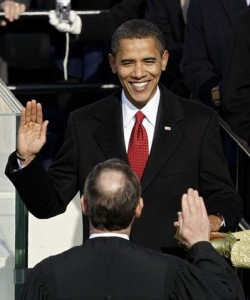 Of course, when it comes to action-packed heroics, nothing tops this past November’s election and inauguration, right, of the current president. It was an achievement which moved many white people to quickly declare the age of Obama “post-racial.” A greater number said, more generously, but no less absurdly, that, in the wake of seating a Black president, “America had changed forever.” Pundit after pundit, in kind, asserted America’s “maturity” with this act.
Of course, when it comes to action-packed heroics, nothing tops this past November’s election and inauguration, right, of the current president. It was an achievement which moved many white people to quickly declare the age of Obama “post-racial.” A greater number said, more generously, but no less absurdly, that, in the wake of seating a Black president, “America had changed forever.” Pundit after pundit, in kind, asserted America’s “maturity” with this act.
Doesn’t having white people write their own absolution preserve white supremacy as a system? All of this, to me, had the quality of, after a home invasion and robbery, agreeing to let the thief fill out one’s insurance claim and police report. At the very least, one can agree that having the people who have victimized you quantify your mistreatment invokes a sizable conflict of interest.
Though all of the above is deeply relevant, none of this was on my mind Tuesday night, when, while watching American Idol, I saw an Old Navy commercial, titled “Mid-Town Flash,” below, in which a white actor, with one brisk move, strips off a Black female mannequin’s dress, leaving the figure, above, save for modesty bars, completely naked, smiling, and being curiously observed by her fellow mannequins, or “supermodelquins,” as the group are called in the corporation’s series of ads.
Continue reading →
February 11th, 2009 — Design, Fashion
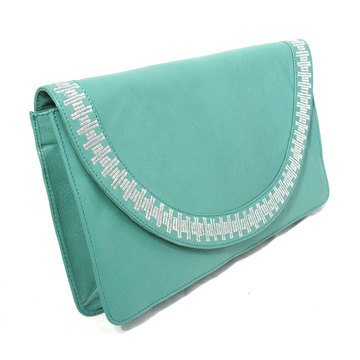
Thirty-two-year-old Londoner Emily Cheetham, founder of handbag proprietor Cheet London, never studied design in school. As she says, on the excellent Handbag Designer 101 blog, “I worked in media & PR and studied Art History and Italian at university, so my skills are largely self-taught!”
She taught herself well, indeed: Her $175 Wallace Clutch, above, fashioned irresistibly in mint from lambs nappa, catches the eye with chroma, only to soothe it with classic styling and details. Perfect for the lady—or perhaps the First Lady!—in your life…wouldn’t you say?
February 4th, 2009 — Design, Fashion

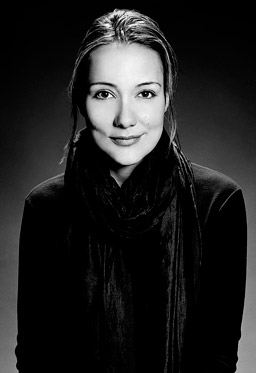 Devi Kroell’s “Bubble in Shiny Mango with Gold Bubbles” shoe, above, adds a freaky, dreamlike psychological element—gilt champagne bubbles ascending the back of its heel—to an already sexily teetering pair of platforms.
Devi Kroell’s “Bubble in Shiny Mango with Gold Bubbles” shoe, above, adds a freaky, dreamlike psychological element—gilt champagne bubbles ascending the back of its heel—to an already sexily teetering pair of platforms.
Working extensively in python, the Austrian-born designer, right, also fashions boots, like the one below, and handbags, a lot of them in styles that, like these designs, are completely inappropriate for the office, but that definitely let ’em know whatcha workin’ wit’ up to a light-year in any direction.
Says her bio,
As the daughter of an ambassador father, Kroell  spent her childhood in Indonesia, Philippines, Singapore, Switzerland, Israel, France, and Italy, among other locales. As a result, her signature styles are easily suited to a variety of backdrops and tastes.From her original python hobo bag to her crystal-studded wooden clutches and avant-garde heels, all of Kroell’s impeccably crafted designs feature sleek, effortless shapes fused with lush, tactile elements.
spent her childhood in Indonesia, Philippines, Singapore, Switzerland, Israel, France, and Italy, among other locales. As a result, her signature styles are easily suited to a variety of backdrops and tastes.From her original python hobo bag to her crystal-studded wooden clutches and avant-garde heels, all of Kroell’s impeccably crafted designs feature sleek, effortless shapes fused with lush, tactile elements.
Tactile, yes. I’d like to touch that.
[via Handbag Designer 101]
December 31st, 2008 — Design, Fashion

 Need a hot look you definitely won’t see on anyone else at tonight’s New Year’s Eve party? Before she died in September, Japanese artist / filmmaker Nagi Noda left behind designs for these startling Hair Hats, which sculpt actual human locks into likenesses of majestic animals. For example, check out the walrus, above, or this proud Afghan Hound, right. Next time someone says you have poodle hair, thank them! And no animals were harmed in the making of these hats: Just your dignity.
Need a hot look you definitely won’t see on anyone else at tonight’s New Year’s Eve party? Before she died in September, Japanese artist / filmmaker Nagi Noda left behind designs for these startling Hair Hats, which sculpt actual human locks into likenesses of majestic animals. For example, check out the walrus, above, or this proud Afghan Hound, right. Next time someone says you have poodle hair, thank them! And no animals were harmed in the making of these hats: Just your dignity.
[via Yanko Design]
December 16th, 2008 — Controversy, Fashion, Humor, Politics
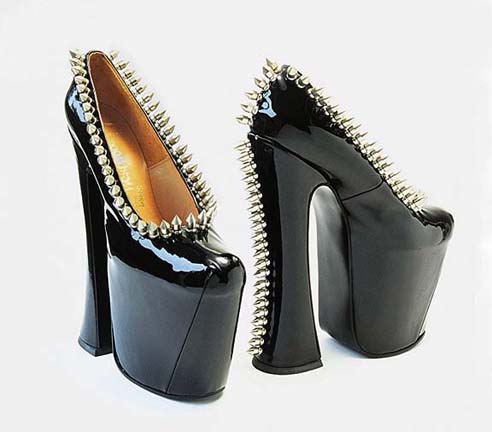
Dame Vivienne Westwood’s killer 10-inch, Anglomania heels,
from the collection of the Bata Shoe Museum. Photo by Nicola Betts
Dear readers of MEDIA ASSASSIN:
There is an oversight to which I must own up.
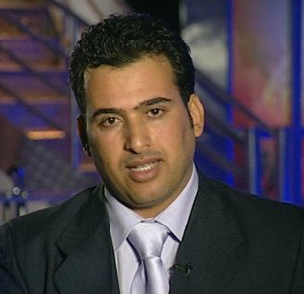 Yesterday, when I put together my prospective rogue’s list of deadly, would-be Presidential shoe-throwers—Wayne Gretzky, Shaq, Pinball Wizard, Bozo the Clown, Frankenstein—in the wake of the controversy around Iraqi newscaster Muntader al-Zaidi, right, who, the day before, threw his shoes at President Bush during a press conference, I tried to be thorough. I wanted to compile a complete roster of people for whom President Bush, in his waning days as our nation’s leader, might keep out an alert eye. To me, it was a matter of national…well, no…clearly, it was a matter of international security.
Yesterday, when I put together my prospective rogue’s list of deadly, would-be Presidential shoe-throwers—Wayne Gretzky, Shaq, Pinball Wizard, Bozo the Clown, Frankenstein—in the wake of the controversy around Iraqi newscaster Muntader al-Zaidi, right, who, the day before, threw his shoes at President Bush during a press conference, I tried to be thorough. I wanted to compile a complete roster of people for whom President Bush, in his waning days as our nation’s leader, might keep out an alert eye. To me, it was a matter of national…well, no…clearly, it was a matter of international security.
But I failed.
I forgot to include Vivienne Westwood.
Continue reading →
December 8th, 2008 — Fashion, Music Video, Politics
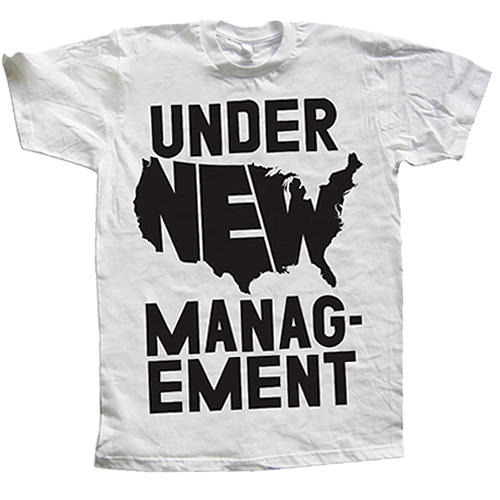
Available in XS-XL for $16 ($22 in heather gray), this t-shirt, above, boasts an outline of the U.S. map that, celebrating our recent general election’s outcome, forms the words, “UNDER NEW MANAGEMENT.”
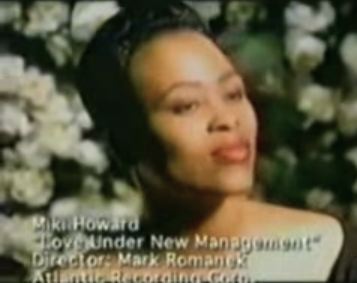 But given the passionate American outburst over Barack Obama and his ascension, not to mention the upcoming inaugural, perhaps, evoking singer Miki Howard’s exultant 1989 hit, right, that shirt should read “IN LOVE UNDER NEW MANAGEMENT.” You know what I mean?
But given the passionate American outburst over Barack Obama and his ascension, not to mention the upcoming inaugural, perhaps, evoking singer Miki Howard’s exultant 1989 hit, right, that shirt should read “IN LOVE UNDER NEW MANAGEMENT.” You know what I mean?
And, in a related-unrelated, here’s a surprise that surprised me: Squint and check the director’s credit on Howard’s video.
Continue reading →


 Well, if that’s your steez,
Well, if that’s your steez, 




 What Baldwin, right, meant by that is what Black people state when they, speaking of the same conditions, inelegantly say, “Samo, samo.” In other words, same old thing, nothing’s different in any meaningful way. “You try and get ahead and they change the rules.” Whatever Black people do, white supremacy merely adapts. Or, as I often urge, “Why would they change what works?”
What Baldwin, right, meant by that is what Black people state when they, speaking of the same conditions, inelegantly say, “Samo, samo.” In other words, same old thing, nothing’s different in any meaningful way. “You try and get ahead and they change the rules.” Whatever Black people do, white supremacy merely adapts. Or, as I often urge, “Why would they change what works?” Of course, when it comes to action-packed heroics, nothing tops this past November’s election and inauguration, right, of the current president. It was an achievement which moved many white people to quickly declare the age of Obama “post-racial.” A greater number said, more generously, but no less absurdly, that, in the wake of seating a Black president, “America had changed forever.” Pundit after pundit, in kind, asserted America’s “maturity” with this act.
Of course, when it comes to action-packed heroics, nothing tops this past November’s election and inauguration, right, of the current president. It was an achievement which moved many white people to quickly declare the age of Obama “post-racial.” A greater number said, more generously, but no less absurdly, that, in the wake of seating a Black president, “America had changed forever.” Pundit after pundit, in kind, asserted America’s “maturity” with this act.









